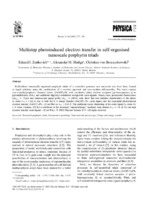Multistep photoinduced electron transfer in self-organised nano-scale porphyrin triads

Date
2002Bibliographic entry
Zenkevich, E. I. Multistep photoinduced electron transfer in self-organised nano-scale porphyrin triads / E. I. Zenkevich [et al.] // Physica E. – 2002. – Vol. 14, № 1-2. – P. 277-281.
Abstract
Well-defined structurally organised porphyrin triads of a controlled geometry andnanoscale size have been formed in liquid solutions using the combination of a covalent approach and non-covalent self-assembly. The triads contain zinc-octaethylporphyrin chemical dimer, (ZnOEP)₂Ph, with covalently linked electron acceptors (p-benzoquinone, Q or pyromellitimide, Pim), and additional dipyridyl-substituted tetrapyrrole extra-ligands. Steady-state, picosecond fluorescence (∆ₜ½ ≈ 75 ps) and femtosecond pump–probe (⊿½ ≈ 280 fs) data show that non-radiative deactivation of the dimer
S₁-states (τₛ < 1 ps) is due to both the S–S energy transfer (ZnOEP)₂Ph→extra-ligand and the sequential photoinduced electron transfer (ZnOEP)₂Ph→Q (or Pim) at r_DA = 10.8 Å. The additional decay shortening of the extra-ligand S₁-states by 3–6 times (toluene, 293 K) is attributed to the increased “superexchange” mediated long distant (r_DA ≈ 18–21 Å) one-step electron transfer extra-ligand→Q (or Pim). © 2002 Elsevier Science B.V. All rights reserved.
